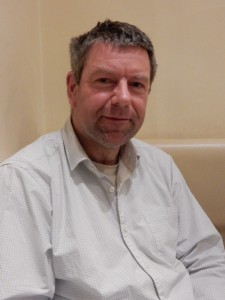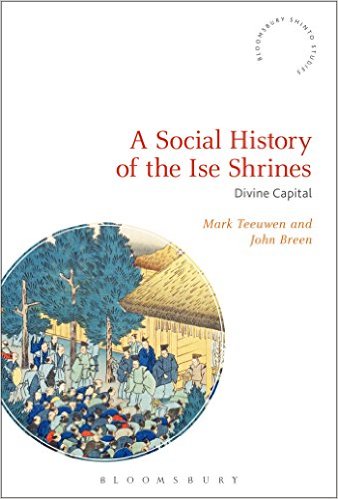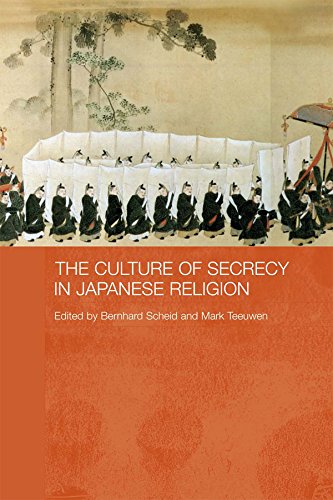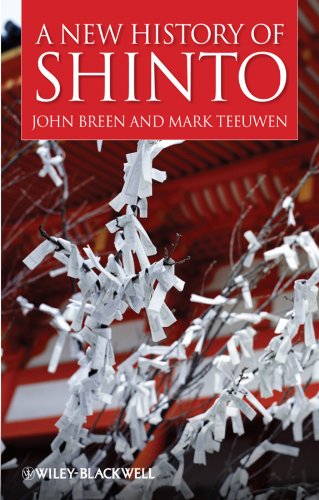
Green Shinto was delighted to meet Mark Teeuwen on his recent visit to Kyoto and have a chance to get an interview with him. Mark (b.1966) is a professor of Japanese Religions at Oslo University and author of several influential works on Shinto. He is perhaps best known for questioning the notion of Shinto as an ancient indigenous religion (see here). He is also the co-author of A New History of Shinto (2010) and Shinto in History (1999).
*****************
1) How did you become interested in Shinto?
I’m not sure! I was interested in history, and especially in the history of ideas when I was a student, because it fascinated me to read texts where writers reasoned in ways that seemed exotic or even slightly absurd to me. I was writing my thesis about Motoori Norinaga (1730-1801) when I got a small job as interpreter in Holland for a Shinto priest, who was interested in the enthronement ceremonies of the royal house. He offered me a chance to come and study at Kogakkan in Ise, so I chose “Motoori Norinaga and the Ise shrines” as my thesis topic. I spent 18 months at Kogakkan as a Research student after that, on a Monbusho scholarship, to prepare for my PhD application. Basically, Shinto was what crossed my path at a crucial moment, and I’m delighted that it did!
2) You’re a Dutchman teaching in Norwegian at Oslo University. How did that come about?
Well, you go where the jobs are these days. But I must admit there’s more to it: my wife is half Norwegian and has family there, and it’s nice to be around family when you have small kids. I got lucky and there did happen to be a job opening, again when we most needed it. I’ve been a lucky guy.
3) In your writings, you seem to deny the existence of Shinto in ancient times. But would it not be fair to describe the mix of folkore, customs, myth and rituals in those days as ‘proto-Shinto’?
You can invent terms like that, and I have no problem with that. Actually, you will find ‘proto-Shinto’ used in A New History of Shinto. My method though is to avoid reading historical materials with hindsight, and to try as hard as possible to stay within the contemporary context. When I read documents from the ancient period, and find that Shinto is not a concept that existed at that time, I try to figure out what the actual concepts were that WERE current at that time, and how shrines and their rites fitted into them. Then it also becomes possible to probe when the concept of Shinto actually DID come about, and how its emergence affected shrines. I find this helps me to ask better questions and avoid reading later ideas into early texts.
4) Of which of your writings so far are you the proudest?
The last of course… That would be A Social History of Ise Shrines, soon out from Bloomsbury in their series of Shinto studies (early 2017). But I also have a particular liking for the book I edited with Bernhard Scheid, The Culture of Secrecy in Japanese Religion (Routledge 2006), and for A New History, which is quite widely used as a university textbook.

The eagerly awaited book on Ise by Teeuwen and Breen, out on Feb 9, 2017
5) Could you tell us a little about your forthcoming book with John Breen on the subject of Ise Jingu?
The idea of the book is to highlight moments in history when the Ise shrines changed hands — that is, when new social groups emerged who redeveloped the shrines along new economic or political models. We identify 8 phases, I believe, each with their own main agents (often multiple), their own clienteles, ritual practices, and narratives. We want to make clear that behind the standard story of never-changing Ise, there is a very rich reality, and we try to highlight the great creativity of the people who reinvented Ise after each crisis that the shrines faced in their long history.
6) You’ve been on the board of International Shinto Foundation for many years. Many foreigners have wondered exactly what it is. Could you tell us about its aims and activities?
The ISF, now called ISSA, has tried to establish and promote Shinto studies abroad (by donating text collections like Shinto Taikei and founding a number of Shinto Chairs at British and US universities) and encourage exchange between foreign and Japanese scholars of Shinto. It has also tried to promote interest in Shinto more broadly. What I particularly appreciate is that the ISF went out of its way to include scholars from Korea and China, with some serving as riji [on the board] and others giving talks. Budgetary problems have forced the Foundation to reduce its activities radically in recent years, however.
7) One final question: what’s your view of the present direction of Shinto in Japan?
It is going two ways; greener, and more nationalist, it seems. I am worried about the broadened influence of groups like Nippon Kaigi, turning Shinto into a less open organization with a narrower spectrum of views and outlooks. Environmentalist concerns need every spokesman they can get, and if shrines get involved in this, environmentalism will be more clearly rooted in Japanese culture and history. On the other hand, the proof is in the eating, and I am afraid that Jinja Honcho support for nuclear energy (and many other points on Abe’s agenda) will stop shrines from engaging actively in alternative routes towards a greener future.
I hope Shinto remains the cauldron of different opinions and agendas that it is today, and does not go the same way as Yasukuni: from a multifaceted site reflecting the views and concerns of the izoku [bereaved families] in all their great variety, to a place where ultraconservatives push out all others.



Thank you so much for the great interview. It helped me understand Shinto.
Hi Mark,
It was interesting to read your interview.
I’m an artist living in London and have been pursuing a project painting portraits of priests from the major global religions, for example a Sikh, Hindu, Zoroastrian, Catholic, Confucian, Orthodox and so on.
I need to find a Shinto priest, understanding that I will have to travel to Japan, and was wondering whether you might have any advice in finding a suitable priest. This project is non profit and the collection of portraits will be donated during an interfaith meeting.
Kind regards,
Anthony